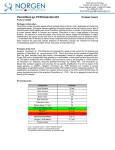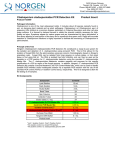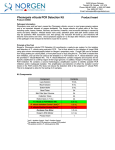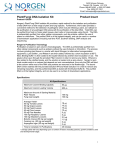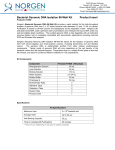Download Protocol (50 prep) - Norgen Biotek Corp.
Transcript
3430 Schmon Parkway Thorold, ON, Canada L2V 4Y6 Phone: 866-667-4362 (905) 227-8848 Fax: (905) 227-1061 Email: [email protected] Fungi/Yeast Genomic DNA Isolation Kit Product Insert Product # 27300 Norgen’s Fungi/Yeast Genomic DNA Isolation Kit is designed for the rapid preparation of genomic DNA from viable yeast cells, fungal spores or mycelium and Gram-positive bacteria. Genomic DNA is efficiently extracted from the cells by a combination of heat treatment, detergents and the use of provided Bead Tubes. The purified genomic DNA is fully digestible with all restriction enzymes tested, and is completely compatible with downstream applications such as PCR and Southern Blot analysis. Typical yields of genomic DNA will vary depending on the cell density of the yeast or fungal culture and species. The option of an additional lyticase treatment is also provided in order to allow for improved DNA yields for certain fungal and yeast species. Preparation time for a single sample is less then 30 minutes, and each kit contains sufficient materials for 50 preparations. Norgen’s Purification Technology Purification is based on spin column chromatography. The process involves first adding Lysis Buffer L to the fungi or yeast sample. At this point, an optional RNase treatment can be performed if RNA-free genomic DNA is required. Next, the mixture is placed into a provided Bead Tube and the tube is vortexed for 5 minutes in order to efficiently and rapidly homogenize the sample and extract the DNA. The sample is then centrifuged, and the supernatant is transferred to a DNAse-free microcentrifuge tube. Ethanol and Solution BX are added to the lysate, and it is then loaded onto one of the provided spin columns. Norgen’s columns bind nucleic acids in a manner that depends on ionic concentrations, thus only the DNA will bind to the column while the proteins are removed in the flowthrough or retained on top of the resin. The bound DNA is then washed twice using the provided Wash Solution A, and the purified DNA is eluted using the Elution Buffer. The purified DNA can be used in sensitive downstream applications including PCR and Southern blotting. Kit Specification Kit Specifications Maximum Column Binding Capacity 50 g Maximum Column Loading Volume 650 L Maximum Amount of Starting Material: Fungi (wet weight) Yeast or bacterial culture 50 mg 0.5mL-1mL Average Yields* Pichia sp. (Yeast) Botrytis cinerea Fusarium sp. Aspergillus niger Mucor racemosus Cladosporium cladosporioides Penicillium sp. Rhizopus oryzae Alternaria tenuissima 25 g 32 g 42 g 26 g 15 g 12 g 40 g 7 g 30 g Time to Complete 10 Purifications 30 minutes * Yield will vary depending on the type of sample processed 1 Advantages Rapid and convenient method to isolate genomic DNA from different fungi, yeast and Gram-positive bacteria No phenol or chloroform extractions Yields high quality DNA that is ready for PCR and other downstream applications. Kit Components Component Lysis Buffer L Resuspension Solution A Solution BX Wash Solution A Elution Buffer B Bead Tubes Product # 27300 (50 preps) 30 mL 20 mL 28 mL 18 mL 15 mL 50 Spin Columns 50 Collection Tubes 50 Elution tubes (1.7 mL) Product Insert 50 1 Storage Conditions and Product Stability All solutions should be kept tightly sealed and stored at room temperature. These reagents should remain stable for at least 1 year in their unopened containers. Precautions and Disclaimers This kit is designed for research purposes only. It is not intended for human or diagnostic use. Ensure that a suitable lab coat, disposable gloves and protective goggles are worn when working with chemicals. For more information, please consult the appropriate Material Safety Data Sheets (MSDSs). These are available as convenient PDF files online at www.norgenbiotek.com. Customer-Supplied Reagents and Equipment Benchtop microcentrifuge 1.5 mL microcentrifuge tubes 65°C water bath or heating block 96 – 100% ethanol Homogenizer or motor and pestle RNase A (optional) Lyticase (optional) 2 Procedure All centrifugation steps are carried out in a benchtop microcentrifuge. Various speeds are required for different steps, so please check your microcentrifuge specifications to ensure that it is capable of the proper speeds. All centrifugation steps are performed at room temperature. The correct rpm can be calculated using the formula: RPM = RCF (1.118 x 10-5) (r) where RCF = required gravitational acceleration (relative centrifugal force in units of g); r = radius of the rotor in cm; and RPM = the number of revolutions per minute required to achieve the necessary g-force. Notes prior to use: A variable speed centrifuge should be used for maximum kit performance. If a variable speed centrifuge is not available a fixed speed centrifuge can be used, however reduced yields may be observed. Ensure that all solutions are at room temperature prior to use, and that no precipitates have formed. If necessary, warm the solutions and mix well until the solutions become clear again. Prepare a working concentration of the Wash Solution A by adding 42 mL of 96 - 100 % ethanol (provided by the user) to the supplied bottle containing the concentrated Wash Solution A. This will give a final volume of 60 mL. The label on the bottle has a box that may be checked to indicate that the ethanol has been added. 8 The maximum yeast or bacteria input amount should not exceed 1 x 10 cfu’s. Depending on culture growth, this is equivalent to approximately 0.5 to 1.0 mL of an overnight culture. For the isolation of genomic DNA from fungal species other than yeast, Collection Solution must be prepared. Collection Solution consists of 0.9% (w/v) NaCl prepared with distilled water. Preheat a water bath or heating block to 65°C. Optional: The DNA yield from some fungal species may be increased by performing an optional Lyticase lysis step. If desired, prepare a Lyticase stock solution according to the supplier’s instruction. It is recommended that the stock solution have a minimum concentration of 4 units per L. Aliquot and store the unused portions at -20°C until needed. 1A. Lysate Preparation (Fungi Growing on Plates or Culture) a. Fungi Growing on Plates: Add approximately 5 mL (volume can be adjusted based on density of fungal growth) of Collection Solution (see notes before use) to the plate and gently collect fungal spores and mycelium with an inoculation loop or autoclaved pipette tip, ensuring not to collect any agar debris. Transfer up to 1 mL of washed spores and wet mycelium to a microcentrifuge tube (provided by user). Fungi in Culture: For fungi growing in a culture, transfer 50 mg of fungi (wet weight) to a microcentrifuge tube. b. Centrifuge at 14,000 x g (~14,000 RPM) for 1 minute to pellet the cells. Pour off the supernatant carefully so as not to disturb or dislodge the cell pellet. 3 c. Add 500 L of Lysis Buffer L to the cell pellet. Resuspend the cells by gentle vortexing. (Optional RNase A treatment) If RNA-free genomic DNA is required, add the equivalent of 10 KUnitz of RNase A (not to exceed 20 L) to the cell suspension. d. Transfer the mixture to a provided Bead Tube and secure the tube horizontally on a flatbed vortex pad with tape, or in any commercially available bead beater equipment (e.g. TM MP Biomedicals’ FastPrep® -24 or Scientific Industries’ Disruptor Genie ). e. Vortex for 5 minutes at maximum speed or optimize the condition for any commercially available bead beater equipment Note: Foaming during the homogenization is common. This foaming is due to detergents present in the Lysis Buffer L and will not affect the protocol. o f. Incubate the Bead Tube with lysate at 65 C for 10 minutes. Occasionally mix the lysate 2 or 3 times during incubation by inverting the tube. g. Briefly spin the tube to remove liquid from the cap, and transfer all of the lysate, including cell debris, to a DNase-free microcentrifuge tube (provided by the user) by pipetting. Ensure that the beads are not transferred during the pipetting. h. Centrifuge the tube for 2 minute at 14000 × g (~14,000 RPM). i. Carefully transfer clean supernatant to a new DNase-free microcentrifuge tube (provided by the user) without disturbing the pellet. Note the volume. j. Add an equal volume of 96%-100% ethanol (provided by the user) to the lysate collected above (100 L of ethanol is added to every 100 L of lysate). Vortex to mix. k. Add 300 L of Solution BX and briefly vortex to mix. l. Proceed to Step 2: Binding to Column 1B. Lysate Preparation with Lyticase (Optional) In general, no extra enzymes are required to lyse fungal cells when using this kit. However, the combination of using the Bead Tubes with Lyticase will improve DNA yield for certain fungal and Gram-positive bacterial species. If low DNA yield is expected, please follow the alternative lysis step provided below. a. Follow step 1Aa and 1Ab as above. b. Add 250 L of Resuspension Solution A to the cell pellet. Resuspend the cells by gentle vortexing. c. Add 200 units of Lyticase (see Notes prior to use) and mix well. Incubate at 37°C for 45 minutes. Note: The time for incubation may vary from 30 minutes to 1 hour. Please refer to the Lyticase manufacturer’s instruction. d. Proceed to step 1Ac. 1C. Lysate Preparation (Yeast and Gram-positive Bacteria) 8 a. Transfer up to 1 mL of yeast or Gram-positive bacterial culture (maximum input 1 x 10 cfu’s) to a microcentrifuge tube and centrifuge at 14,000 x g (~14,000 RPM) for 1 minute to pellet the cells. Pour off the supernatant carefully so as not to disturb or dislodge the cell pellet. b. Proceed to Step 1Ac. 4 2. Binding Nucleic Acids to Column a. Obtain a spin column assembled with its collection tube. b. Apply up to 650 L of the lysate with ethanol onto the column and centrifuge for 1 minute at 10,000 x g (~10,000 RPM). Discard the flowthrough and reassemble the spin column with the collection tube. Note: Ensure the entire lysate volume has passed through into the collection tube by inspecting the column. If the entire lysate volume has not passed, spin for an additional minute. c. Repeat step 2b with remained lysate. 3. Column Wash a. Apply 500 L of Wash Solution A to the column and centrifuge for 1 minute at 10,000 x g (~10,000 RPM). Note: Ensure the entire wash solution A has passed through into the collection tube by inspecting the column. If the entire wash volume has not passed, spin for an additional minute. b. c. d. e. Discard the flowthrough and reassemble the column with its collection tube. Repeat step 3a to wash column a second time. Discard the flowthrough and reassemble the spin column with its collection tube. Spin the column for 2 minutes at 14,000 x g (~14,000 RPM) in order to thoroughly dry the resin. Discard the collection tube. 4. Nucleic Acid Elution a. Place the column into a fresh 1.7 mL Elution tube provided with the kit. b. Add 100 L of Elution Buffer B to the column. c. Centrifuge for 2 minutes at 10,000 x g (~10,000 RPM). Note the volume eluted from the column. If the entire volume has not been eluted, spin the column at 14,000 x g (~14,000 RPM) for 1 additional minute. d. (Optional): An additional elution may be performed if desired by repeating steps 4b and 4c using 100 L of Elution Buffer B. To prevent dilution of the elution it is recommended that a separate elution tube is used for the second elution. The total yield can be improved by an additional 20 – 30% when this second elution is performed. Note: For maximum PCR robustness, we recommend using 20-50 ng of DNA and adding BSA to the PCR mix to a final concentration of 0.1 μg/μL. 5. Storage of DNA The purified nucleic acids may be stored at –20°C for a few days. It is recommended that samples be placed at –70°C for long term storage. 5 Troubleshooting Guide Problem The micro spin column is clogged. Turbid elution Poor DNA Recovery DNA does not perform well in downstream applications Possible Cause Solution and Explanation The sample is too large Too many cells were applied to the column. Ensure that 8 the amount of cells used is less than 1 x 10 viable yeast cells or 50 mg (wet weight) of fungal culture. Clogging can be alleviated by increasing the g-force and/or centrifuging for a longer period of time until the lysate passes through the column. The sample is too large Depending on fungi species, sometimes turbidity can be observed in the elution. This may inhibit downstream application. Reduce the amount of cells used, and perform a third wash during the Column Wash step. Lysis was not completed Increase the incubation time at 65ºC to 15 minutes. Ethanol was not added to the Wash Solution A Ensure that 42 mL of 96 - 100% ethanol is added to the supplied Wash Solution A prior to use. Solution BX was not added to the lysate Solution BX enhances DNA binding to the column for maximum DNA recovery. The sample is too large Too many cells were applied to the column. Ensure that 8 the amount of cells used is less than 1 x 10 viable yeast/bacterial cells or 50 mg (wet weight) of fungal culture. Ethanol carryover Ensure that the dry spin under the Column Wash procedure is performed, in order to remove traces of ethanol prior to elution. Ethanol is known to interfere with many downstream applications. The column was not washed twice with the provided Wash Solution A Traces of salt from the binding step may remain in the sample if the column is not washed twice with the Wash Solution A. Salt may interfere with downstream applications, and thus must be washed from the column. PCR reaction conditions need to be optimized Take steps to optimize the PCR conditions being used, including varying the amount of template (20 ng to 50 ng for 20 L of PCR reaction), changing the source of Taq polymerase, adding BSA (final concentration is 0.1 μg/μl), looking into the primer design and adjusting the annealing conditions. 6 Related Products HighRanger 1kb DNA Ladder UltraRanger 1kb DNA Ladder Bacterial Genomic DNA Isolation Kit Plant/Fungi DNA Isolation Kit Product # 11900 12100 17900 26200 Technical Support Contact our Technical Support Team between the hours of 8:30 and 5:30 (Eastern Standard Time) at (905) 227-8848 or Toll Free at 1-866-667-4362. Technical support can also be obtained from our website (www.norgenbiotek.com) or through email at [email protected]. 3430 Schmon Parkway, Thorold, ON Canada L2V 4Y6 Phone: (905) 227-8848 Fax: (905) 227-1061 Toll Free in North America: 1-866-667-4362 ©2014 Norgen Biotek Corp. PI27300-9-M14 7







